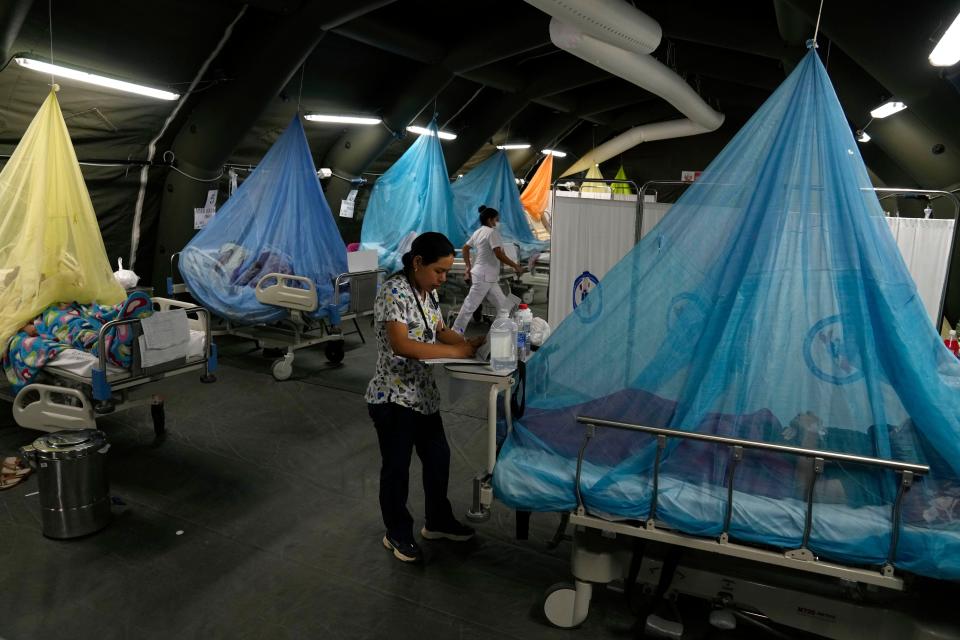As Peru contends with dengue outbreak, here's what to know about virus symptoms, treatment
As millions of homes have been fumigated in the wake of Peru’s worst dengue outbreak on record, the country has declared a state of emergency in 18 of the country's 24 regions to allow official action for "imminent danger from heavy rainfall,” Reuters initially reported this month.
Peruvian health authorities said last week the outbreak was intensified by El Niño.
The weather phenomenon, a cyclical warming of the world’s oceans and weather, fuels tropical cyclones in the Pacific and Reuters reported Peruvian health authorities blamed it as a key driver for the uptick in cases, as mosquitoes prefer wet conditions.
The outbreak also led to Peru's health minister resigning over criticism about her efforts to combat the outbreak, President Dina Boluarte announced Monday.
Here is what you need to know about the virus that has claimed the lives of 273 people and has infected 156,700 others, according to the latest Associated Press report.

ICYMI: At least 200 dead, more than 130,000 infected: Peru battles major dengue outbreak
What is dengue?
Humans become infected with any of the four related dengue viruses by the bite of an infected a species of mosquito known as the Aedes species, according to the Centers for Disease Control and Prevention.
A person can be infected with dengue multiple times over the course of their life.
About 1 in 20 people who get sick with dengue experience a severe case.
What are the symptoms of dengue?
Headaches and body aches, fever, nausea and rashes are some of the most common symptoms when infected, but most people who become infected are asymptomatic, the World Health Organization reports.
If symptoms do occur, they become apparent within four to 10 days after infection.
The more times you become infected with dengue, the greater risk you are to develop more severe symptoms including but not limited to: severe abdominal pain, persistent vomiting, rapid breathing, bleeding gums or nose, or fatigue, WHO said.
How to recover from dengue?
Recovery from the virus typically occurs with a couple of weeks for most, but some people may require specialized care since severe cases can lead to death, according to WHO.
The best way to treat the onset of symptoms caused by the dengue virus is with pain medication such as acetaminophen, according to WHO.
Common pain relief medications including ibuprofen or aspirin should be avoided to treat the virus since they can increase the risk of bleeding.
The Dengvaxia dengue vaccine became available in the United States last year, but is only recommended for people between the ages of 9 and 16 years old, who have been infected with the virus before and who live in certain U.S. territories, according to the CDC.
How prevalent is dengue?

According to the CDC, about 4 billion people live in areas with a risk of dengue and up to 400 million people are infected annually.
The number of cases reported to WHO over the last nineteen years have increased dramatically, from 505,430 cases in 2000 to 5.2 million in 2019.
Dengue cases tend to be underreported because most cases are “mild and self-managed,” WHO states.
Dengue is now common in more than 100 countries across Africa, the the Americas, the Eastern Mediterranean, South-East Asia and the Western Pacific. As of 2021, the virus continues to affect people in Brazil, Colombia, the Cook Islands, Fiji, India, Kenya, Paraguay, the Philippines, the Reunion Islands, Vietnam and Peru, according to WHO.
In the United States, the disease is rare in the U.S. mainland, where nearly all cases have been among travelers. When outbreaks do occur, they're typically limited to small areas. Dengue is most common in the U.S. territories of American Samoa, Puerto Rico and the U.S. Virgin Islands, according to the CDC.
This article originally appeared on USA TODAY NETWORK: As Peru dengue fever cases grow, key facts on virus symptoms, recovery

